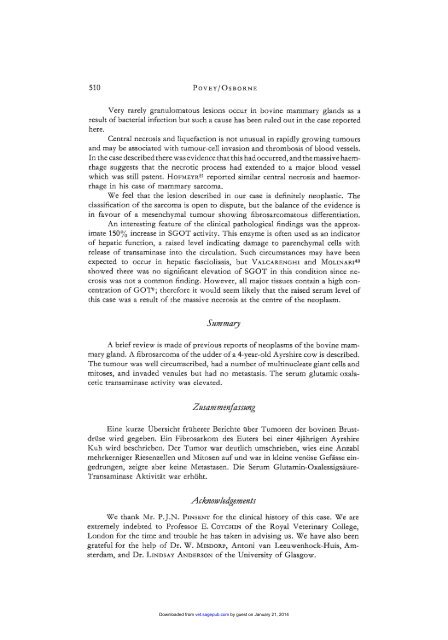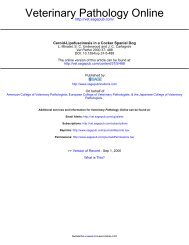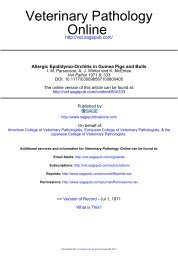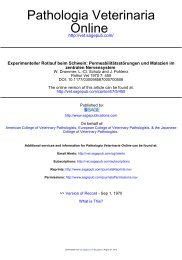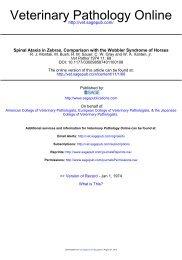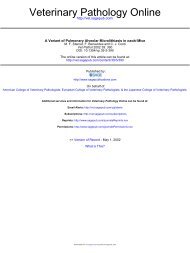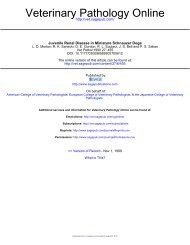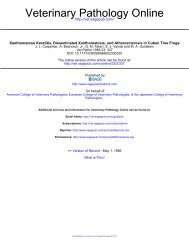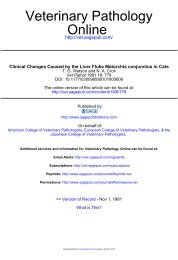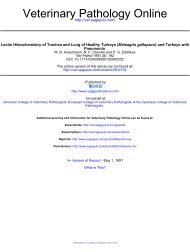Mammary Gland Neoplasia in the Cow - Veterinary Pathology
Mammary Gland Neoplasia in the Cow - Veterinary Pathology
Mammary Gland Neoplasia in the Cow - Veterinary Pathology
Create successful ePaper yourself
Turn your PDF publications into a flip-book with our unique Google optimized e-Paper software.
510 POVEY/OSBORNE<br />
Very rarely granulomatous lesions occur <strong>in</strong> bov<strong>in</strong>e mammary glands as a<br />
result of bacterial <strong>in</strong>fection but such a cause has been ruled out <strong>in</strong> <strong>the</strong> case reported<br />
here.<br />
Central necrosis and liquefaction is not unusual <strong>in</strong> rapidly grow<strong>in</strong>g tumours<br />
and may be associated with tumour-cell <strong>in</strong>vasion and thrombosis of blood vessels.<br />
In <strong>the</strong> case described <strong>the</strong>re was evidence that this had occurred, and <strong>the</strong> massive haemrhage<br />
suggests that <strong>the</strong> necrotic process had extended to a major blood vessel<br />
which was still patent. HOFMEYR~~ reported similar central necrosis and haemorrhage<br />
<strong>in</strong> his case of mammary sarcoma.<br />
We feel that <strong>the</strong> lesion described <strong>in</strong> our case is def<strong>in</strong>itely neoplastic. The<br />
classification of <strong>the</strong> sarcoma is open to dispute, but <strong>the</strong> balance of <strong>the</strong> evidence is<br />
<strong>in</strong> favour of a mesenchymal tumour show<strong>in</strong>g fibrosarcomatous differentiation.<br />
An <strong>in</strong>terest<strong>in</strong>g feature of <strong>the</strong> cl<strong>in</strong>ical pathological f<strong>in</strong>d<strong>in</strong>gs was <strong>the</strong> approximate<br />
150% <strong>in</strong>crease <strong>in</strong> SGOT activity. This enzyme is often used as an <strong>in</strong>dicator<br />
of hepatic function, a raised level <strong>in</strong>dicat<strong>in</strong>g damage to parenchymal cells with<br />
release of transam<strong>in</strong>ase <strong>in</strong>to <strong>the</strong> circulation. Such circumstances may have been<br />
expected to occur <strong>in</strong> hepatic fascioliasis, but VALCARENGHI and MOLINAR143<br />
showed <strong>the</strong>re was no significant elevation of SGOT <strong>in</strong> this condition s<strong>in</strong>ce necrosis<br />
was not a common f<strong>in</strong>d<strong>in</strong>g. However, all major tissues conta<strong>in</strong> a high concentration<br />
of GOTJ; <strong>the</strong>refore it would seem likely that <strong>the</strong> raised serum level of<br />
this case was a result of <strong>the</strong> massive necrosis at <strong>the</strong> centre of <strong>the</strong> neoplasm.<br />
A brief review is made of previous reports of neoplasms of <strong>the</strong> bov<strong>in</strong>e mammary<br />
gland. A fibrosarcoma of <strong>the</strong> udder of a 4-year-old Ayrshire cow is described.<br />
The tumour was well circumscribed, had a number of mult<strong>in</strong>ucleate giant cells and<br />
mitoses, and <strong>in</strong>vaded venules but had no metastasis. The serum glutamic oxalacetic<br />
transam<strong>in</strong>ase activity was elevated.<br />
E<strong>in</strong>e kurze Ubersicht friiherer Berichte uber Tumoren der bov<strong>in</strong>en Brustdruse<br />
wird gegeben. E<strong>in</strong> Fibrosarkom des Euters bei e<strong>in</strong>er 4jahrigen Ayrshire<br />
Kuh wird beschrieben. Der Tumor war deutlich umschrieben, wies e<strong>in</strong>e Anzahl<br />
mehrkerniger Riesenzellen und Mitosen auf und war <strong>in</strong> kle<strong>in</strong>e venose Gefasse e<strong>in</strong>gedrungen,<br />
zcigte aber ke<strong>in</strong>e Metastasen. Die Serum Glutam<strong>in</strong>-Oxalessigsaure-<br />
Transani<strong>in</strong>ase Aktivitat war erhoht.<br />
Acknowledgements<br />
We thank 1%. P. J.N. PINSENT for <strong>the</strong> cl<strong>in</strong>ical history of this case. We are<br />
extremely <strong>in</strong>debted to Professor E. COTCHIN of <strong>the</strong> Royal Veter<strong>in</strong>ary College,<br />
London for <strong>the</strong> time and trouble he has taken <strong>in</strong> advis<strong>in</strong>g us. We have also been<br />
grateful for <strong>the</strong> help of Dr. W. MISDORP, Antoni van Leeuwenhock-Huis, Amsterdam,<br />
and Dr. LINDSAY ANDERSON of <strong>the</strong> University of Glasgow.<br />
Downloaded from vet.sagepub.com by guest on January 21, 2014


